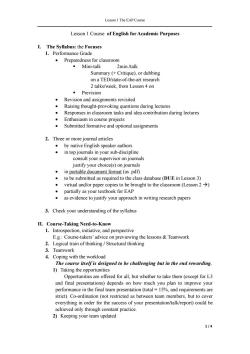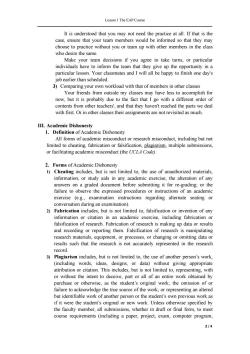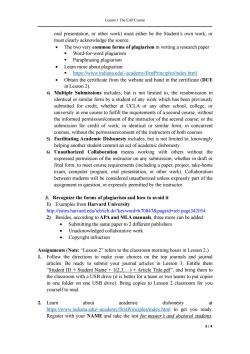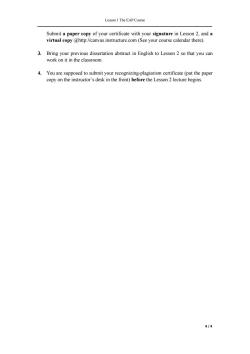上海交通大学:《English for Academic Purposes》课程教学资源(EAP)Handouts_L1 The Course Ss' handout

Lesson 1 The EAP Course Lesson 1 Course of English for Academic Purposes I.The Syllabus:the Focuses 1.Performance Grade Preparedness for classroom ·Mini-talk 2min./talk Summary (Critique),or dubbing on a TED/state-of-the-art research 2 talks/week,from Lesson 4 on Prevision Revision and assignments revisited Raising thought-provoking questions during lectures Responses in classroom tasks and idea contribution during lectures Enthusiasm in course projects Submitted formative and optional assignments 2.Three or more journal articles by native English speaker authors in top journals in your sub-discipline consult your supervisor on journals justify your choice(s)on journals in portable document format(as.pdf) to be submitted as required to the class database(DUE in Lesson 3) virtual and/or paper copies to be brought to the classroom (Lesson 2>) partially as your textbook for EAP as evidence to justify your approach in writing research papers 3.Check your understanding of the syllabus II.Course-Taking Need-to-Know 1.Introspection,initiative,and perspective E.g.:Course-takers'advice on previewing the lessons Teamwork 2.Logical train of thinking /Structural thinking 3.Teamwork 4.Coping with the workload The course itself is designed to be challenging but in the end rewarding. 1)Taking the opportunities Opportunities are offered for all,but whether to take them(except for L3 and final presentations)depends on how much you plan to improve your performance in the final team presentation(total=15%,and requirements are strict).Co-ordination (not restricted as between team members,but to cover everything in order for the success of your presentation/talk/report)could be achieved only through constant practice. 2)Keeping your team updated 1/4
Lesson 1 The EAP Course 1 / 4 Lesson 1 Course of English for Academic Purposes I. The Syllabus: the Focuses 1. Performance Grade Preparedness for classroom Mini-talk 2min./talk Summary (+ Critique), or dubbing on a TED/state-of-the-art research 2 talks/week, from Lesson 4 on Prevision Revision and assignments revisited Raising thought-provoking questions during lectures Responses in classroom tasks and idea contribution during lectures Enthusiasm in course projects Submitted formative and optional assignments 2. Three or more journal articles by native English speaker authors in top journals in your sub-discipline consult your supervisor on journals justify your choice(s) on journals in portable document format (as .pdf) to be submitted as required to the class database (DUE in Lesson 3) virtual and/or paper copies to be brought to the classroom (Lesson 2 ) partially as your textbook for EAP as evidence to justify your approach in writing research papers 3. Check your understanding of the syllabus II. Course-Taking Need-to-Know 1. Introspection, initiative, and perspective E.g.: Course-takers’ advice on previewing the lessons & Teamwork 2. Logical train of thinking / Structural thinking 3. Teamwork 4. Coping with the workload The course itself is designed to be challenging but in the end rewarding. 1) Taking the opportunities Opportunities are offered for all, but whether to take them (except for L3 and final presentations) depends on how much you plan to improve your performance in the final team presentation (total = 15%, and requirements are strict). Co-ordination (not restricted as between team members, but to cover everything in order for the success of your presentation/talk/report) could be achieved only through constant practice. 2) Keeping your team updated

Lesson 1 The EAP Course It is understood that you may not need the practice at all.If that is the case,ensure that your team members would be informed so that they may choose to practice without you or team up with other members in the class who desire the same. Make your team decisions if you agree to take turns,or particular individuals have to inform the team that they give up the opportunity in a particular lesson.Your classmates and I will all be happy to finish one day's job earlier than scheduled. 3)Comparing your own workload with that of members in other classes Your friends from outside my classes may have less to accomplish for now,but it is probably due to the fact that I go with a different order of contents from other teachers',and that they haven't reached the parts we deal with first.Or in other classes their assignments are not revisited as much. III.Academic Dishonesty 1.Definition of Academic Dishonesty All forms of academic misconduct or research misconduct,including but not limited to cheating,fabrication or falsification,plagiarism,multiple submissions, or facilitating academic misconduct (the UCLA Code). 2.Forms of Academic Dishonesty 1)Cheating includes,but is not limited to,the use of unauthorized materials, information,or study aids in any academic exercise;the alteration of any answers on a graded document before submitting it for re-grading;or the failure to observe the expressed procedures or instructions of an academic exercise (e.g.,examination instructions regarding alternate seating or conversation during an examination). 2)Fabrication includes,but is not limited to,falsification or invention of any information or citation in an academic exercise,including fabrication or falsification of research.Fabrication of research is making up data or results and recording or reporting them.Falsification of research is manipulating research materials,equipment,or processes,or changing or omitting data or results such that the research is not accurately represented in the research record. 3)Plagiarism includes,but is not limited to,the use of another person's work, (including words,ideas,designs,or data)without giving appropriate attribution or citation.This includes,but is not limited to,representing,with or without the intent to deceive,part or all of an entire work obtained by purchase or otherwise,as the student's original work;the omission of or failure to acknowledge the true source of the work;or representing an altered but identifiable work of another person or the student's own previous work as if it were the student's original or new work.Unless otherwise specified by the faculty member,all submissions,whether in draft or final form,to meet course requirements (including a paper,project,exam,computer program, 2/4
Lesson 1 The EAP Course 2 / 4 It is understood that you may not need the practice at all. If that is the case, ensure that your team members would be informed so that they may choose to practice without you or team up with other members in the class who desire the same. Make your team decisions if you agree to take turns, or particular individuals have to inform the team that they give up the opportunity in a particular lesson. Your classmates and I will all be happy to finish one day's job earlier than scheduled. 3) Comparing your own workload with that of members in other classes Your friends from outside my classes may have less to accomplish for now, but it is probably due to the fact that I go with a different order of contents from other teachers', and that they haven't reached the parts we deal with first. Or in other classes their assignments are not revisited as much. III. Academic Dishonesty 1. Definition of Academic Dishonesty All forms of academic misconduct or research misconduct, including but not limited to cheating, fabrication or falsification, plagiarism, multiple submissions, or facilitating academic misconduct (the UCLA Code). 2. Forms of Academic Dishonesty 1) Cheating includes, but is not limited to, the use of unauthorized materials, information, or study aids in any academic exercise; the alteration of any answers on a graded document before submitting it for re-grading; or the failure to observe the expressed procedures or instructions of an academic exercise (e.g., examination instructions regarding alternate seating or conversation during an examination). 2) Fabrication includes, but is not limited to, falsification or invention of any information or citation in an academic exercise, including fabrication or falsification of research. Fabrication of research is making up data or results and recording or reporting them. Falsification of research is manipulating research materials, equipment, or processes, or changing or omitting data or results such that the research is not accurately represented in the research record. 3) Plagiarism includes, but is not limited to, the use of another person’s work, (including words, ideas, designs, or data) without giving appropriate attribution or citation. This includes, but is not limited to, representing, with or without the intent to deceive, part or all of an entire work obtained by purchase or otherwise, as the student’s original work; the omission of or failure to acknowledge the true source of the work; or representing an altered but identifiable work of another person or the student’s own previous work as if it were the student’s original or new work. Unless otherwise specified by the faculty member, all submissions, whether in draft or final form, to meet course requirements (including a paper, project, exam, computer program

Lesson 1 The EAP Course oral presentation,or other work)must either be the Student's own work,or must clearly acknowledge the source. The two very common forms of plagiarism in writing a research paper Word-for-word plagiarism Paraphrasing plagiarism Learn more about plagiarism https://www.indiana.edu/-academy/firstPrinciples/index.html Obtain the certificate from the website and hand in the certificate (DUE in Lesson 2). 4)Multiple Submissions includes,but is not limited to,the resubmission in identical or similar form by a student of any work which has been previously submitted for credit,whether at UCLA or any other school,college,or university in one course to fulfill the requirements of a second course,without the informed permission/consent of the instructor of the second course;or the submission for credit of work,in identical or similar form,in concurrent courses,without the permission/consent of the instructors of both courses. 5)Facilitating Academic Dishonesty includes,but is not limited to,knowingly helping another student commit an act of academic dishonesty. 6)Unauthorized Collaboration means working with others without the expressed permission of the instructor on any submission,whether in draft or final form,to meet course requirements(including a paper,project,take-home exam,computer program,oral presentation,or other work).Collaboration between students will be considered unauthorized unless expressly part of the assignment in question,or expressly permitted by the instructor. 3.Recognize the forms of plagiarism and how to avoid it 1)Examples from Harvard University http://isites.harvard.edu/icb/icb.do?keyword=k70847&pageid=icb.page342054 2)Besides,according to APA and MLA manuals,three more can be added: Submitting the same paper to 2 different publishers Unacknowledged collaborative work Copyright infraction Assignments(Note:"Lesson 2"refers to the classroom morning hours in Lesson 2.) 1.Follow the directions to make your choices on the top journals and journal articles.Be ready to submit your journal articles in Lesson 3:Entitle them "Student ID Student Name 1(2.3...)+Article Title.pdf",and bring them to the classroom with a USB drive (it is better for a team or two teams to put copies in one folder on one USB drive).Bring copies to Lesson 2 classroom for you yourself to read. 2.Learn about academic dishonesty at https://www.indiana.edu/-academy/firstPrinciples/index.html to get you ready. Register with your NAME and take the test for master's and doctoral students. 3/4
Lesson 1 The EAP Course 3 / 4 oral presentation, or other work) must either be the Student’s own work, or must clearly acknowledge the source. The two very common forms of plagiarism in writing a research paper Word-for-word plagiarism Paraphrasing plagiarism Learn more about plagiarism https://www.indiana.edu/~academy/firstPrinciples/index.html Obtain the certificate from the website and hand in the certificate (DUE in Lesson 2). 4) Multiple Submissions includes, but is not limited to, the resubmission in identical or similar form by a student of any work which has been previously submitted for credit, whether at UCLA or any other school, college, or university in one course to fulfill the requirements of a second course, without the informed permission/consent of the instructor of the second course; or the submission for credit of work, in identical or similar form, in concurrent courses, without the permission/consent of the instructors of both courses. 5) Facilitating Academic Dishonesty includes, but is not limited to, knowingly helping another student commit an act of academic dishonesty. 6) Unauthorized Collaboration means working with others without the expressed permission of the instructor on any submission, whether in draft or final form, to meet course requirements (including a paper, project, take-home exam, computer program, oral presentation, or other work). Collaboration between students will be considered unauthorized unless expressly part of the assignment in question, or expressly permitted by the instructor. 3. Recognize the forms of plagiarism and how to avoid it 1) Examples from Harvard University http://isites.harvard.edu/icb/icb.do?keyword=k70847&pageid=icb.page342054 2) Besides, according to APA and MLA manuals, three more can be added: Submitting the same paper to 2 different publishers Unacknowledged collaborative work Copyright infraction Assignments (Note: “Lesson 2” refers to the classroom morning hours in Lesson 2.) 1. Follow the directions to make your choices on the top journals and journal articles. Be ready to submit your journal articles in Lesson 3: Entitle them “Student ID + Student Name + 1(2,3,…) + Article Title.pdf”, and bring them to the classroom with a USB drive (it is better for a team or two teams to put copies in one folder on one USB drive). Bring copies to Lesson 2 classroom for you yourself to read. 2. Learn about academic dishonesty at https://www.indiana.edu/~academy/firstPrinciples/index.html to get you ready. Register with your NAME and take the test for master’s and doctoral students

Lesson 1 The EAP Course Submit a paper copy of your certificate with your signature in Lesson 2,and a virtual copy @http://canvas.instructure.com(See your course calendar there). 3.Bring your previous dissertation abstract in English to Lesson 2 so that you can work on it in the classroom. 4.You are supposed to submit your recognizing-plagiarism certificate(put the paper copy on the instructor's desk in the front)before the Lesson 2 lecture begins. 4/4
Lesson 1 The EAP Course 4 / 4 Submit a paper copy of your certificate with your signature in Lesson 2, and a virtual copy @http://canvas.instructure.com (See your course calendar there). 3. Bring your previous dissertation abstract in English to Lesson 2 so that you can work on it in the classroom. 4. You are supposed to submit your recognizing-plagiarism certificate (put the paper copy on the instructor’s desk in the front) before the Lesson 2 lecture begins
按次数下载不扣除下载券;
注册用户24小时内重复下载只扣除一次;
顺序:VIP每日次数-->可用次数-->下载券;
- 上海交通大学:《English for Academic Purposes》课程教学资源(EAP)Guide to the Course.pptx
- 上海交通大学:《English for Academic Purposes》课程教学资源(EAP)教学大纲.docx
- 《日语精读》课程教学资源(同预习后练习)综合日语——第1課:ゼミとは何か——-预习后练习.docx
- 《日语精读》课程教学资源(同预习后练习)综合日语——第4課:車内で化粧する女性——-预习后练习.docx
- 《日语精读》课程教学资源(同预习后练习)综合日语——第3課:外国人力士の活躍——-预习后练习.docx
- 《日语精读》课程教学资源(同预习后练习)综合日语——第2課:特集 サークル案内——-预习后练习.docx
- 《中国文化概论》课程教学资源:关于中国传统节日的古诗.docx
- 《现代中国文学与文化》课程参考书籍(鲁迅译文全集)第一卷:月界旅行、地底旅行、域外小说集、工人绥惠略夫、现代小说译丛、一个青年的梦、爱罗先珂童话集.pdf
- 《现代中国文学与文化》课程参考书籍(鲁迅全集)第二卷:彷徨、野草、朝花夕拾、故事新编.pdf
- 《现代中国文学与文化》课程参考书籍(鲁迅全集)第一卷:坟、热风、呐喊.pdf
- 《现代中国文学与文化》课程参考书籍:顾城诗全集.pdf
- 《现代中国文学与文化》课程参考书籍(世界名诗大系)舒婷的诗.pdf
- 《现代中国文学与文化》课程参考书籍(郭沫若)《女神》(共三辑).pdf
- 《现代中国文学与文化》课程参考书籍(中国现代文学名著)茅盾作品集:《蚀》.pdf
- 《现代中国文学与文化》课程参考书籍(曹禺全集)四幕悲剧.pdf
- 《现代中国文学与文化》课程参考书籍(中国现代文学百家)张天翼文集.pdf
- 《现代中国文学与文化》课程参考书籍(美人之美)上海文艺出版社《重放的鲜花》.pdf
- 《现代中国文学与文化》课程参考书籍(美人之美)小二黑结婚、李有才板话、孟祥英翻身、地板、福贵.pdf
- 《现代中国文学与文化》课程参考书籍(巴金全集)第1卷:激流三部曲《家》.pdf
- 《现代中国文学与文化》课程参考书籍:《张爱玲文集》第一卷.pdf
- 上海交通大学:《English for Academic Purposes》课程教学资源(EAP)Handouts_L10 The Introduction Ss' handout.docx
- 上海交通大学:《English for Academic Purposes》课程教学资源(EAP)Handouts_L11_Final Team Presentation_On the Final Team Presentation.docx
- 上海交通大学:《English for Academic Purposes》课程教学资源(EAP)Handouts_L11_Final Team Presentation_Outlining Principles.pdf
- 上海交通大学:《English for Academic Purposes》课程教学资源(EAP)Handouts_L11_Final Team Presentation_Planning and Structuring a Presentation.pptx
- 上海交通大学:《English for Academic Purposes》课程教学资源(EAP)Handouts_L11_Final Team Presentation_Sample Preparation Outline.docx
- 上海交通大学:《English for Academic Purposes》课程教学资源(EAP)Handouts_L11_L11 The Conclusion & The Whole Picture STE & ICCI Ss'.docx
- 上海交通大学:《English for Academic Purposes》课程教学资源(EAP)Handouts_L12 Writing the Acknowledgement(s)& Practicing with Text Types Ss'.docx
- 上海交通大学:《English for Academic Purposes》课程教学资源(EAP)Handouts_L2_L2 Template for Optional Abstract writing.docx
- 上海交通大学:《English for Academic Purposes》课程教学资源(EAP)Handouts_L2_L2 The Abstract Ss' handout.docx
- 上海交通大学:《English for Academic Purposes》课程教学资源(EAP)Handouts_L3 Data Commentary Ss' handout.docx
- 上海交通大学:《English for Academic Purposes》课程教学资源(EAP)Handouts_L4 Language styles Ss' handout.docx
- 上海交通大学:《English for Academic Purposes》课程教学资源(EAP)Handouts_L5_Documentation Styles guide.pdf
- 上海交通大学:《English for Academic Purposes》课程教学资源(EAP)Handouts_L5_L5 Reading & Writing Reports Ss' handout.docx
- 上海交通大学:《English for Academic Purposes》课程教学资源(EAP)Handouts_L6 Exposition & the Results Ss' handout.docx
- 上海交通大学:《English for Academic Purposes》课程教学资源(EAP)Handouts_L7 Discussion & the Discussion Ss' handout.docx
- 上海交通大学:《English for Academic Purposes》课程教学资源(EAP)Handouts_L8 Explanation & the Methodology Ss' handout.docx
- 上海交通大学:《English for Academic Purposes》课程教学资源(EAP)Handouts_L9 Procedural & summary Ss' handout.docx
- 上海交通大学:《English for Academic Purposes》课程教学资源(EAP)Handouts_W14_reviewer_response_example.docx
- 上海交通大学:《English for Academic Purposes》课程教学资源(EAP)Handouts_W14_W 14th Outlining & the E-mail Ss' handout.docx
- 上海交通大学:《English for Academic Purposes》课程教学资源(EAP)Handouts_W15 Delivery, Creating Slides, & Q&A Ss' handout.docx
